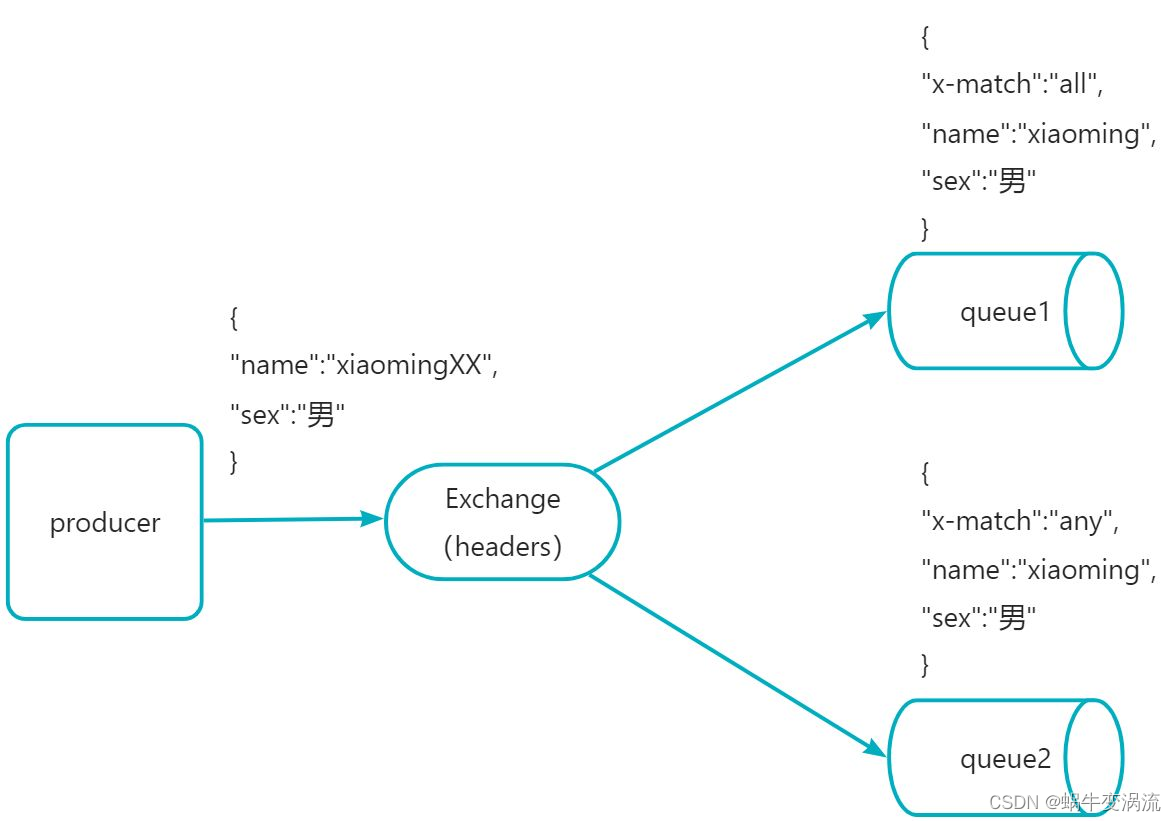目录
1.直连交换机(Direct)
直连交换机通过routingKey绑定交换机和队列,同时在发送消息时,也是通过routingKey找到相对应的队列,特点是一对一发送
生产者代码示例
import com.rabbitmq.client.BuiltinExchangeType;
import com.rabbitmq.client.Channel;
import com.rabbitmq.client.Connection;
import com.rabbitmq.client.ConnectionFactory;
import java.io.IOException;
import java.util.concurrent.TimeoutException;
public class DirectProducer {
public static void main(String[] args) throws IOException, TimeoutException {
ConnectionFactory connectionFactory = new ConnectionFactory();
connectionFactory.setHost("xxx.xxx.xxx.xxx");// 这里写上你自己的ip
connectionFactory.setUsername("admin"); // 这里写上你的MQ服务器对应的账号
connectionFactory.setPassword("123456");// 这里写上你的MQ服务器对应的密码
connectionFactory.setPort(5672);
Connection connection = connectionFactory.newConnection();
Channel channel = connection.createChannel();
// 创建交换机,名称为"direct_exchange_test", 并交换机类型为direct(即下面第二个参数)
channel.exchangeDeclare("direct_exchange_test", BuiltinExchangeType.DIRECT,true,false,null);
// 创建队列,名称为“direct_queue_test”
channel.queueDeclare("direct_queue_test",true,false,false,null);
// 绑定队列,并设置routingKey的名称为 “direct_routing”
channel.queueBind("direct_queue_test","direct_exchange_test","direct_routing");
String message = "消息发送成功!";
//开启监听
channel.basicPublish("direct_exchange_test","direct_routing",null,message.getBytes());
channel.close();
connection.close();
}
}
消费者代码示例
import com.rabbitmq.client.*;
import java.io.IOException;
public class DirectConsumer {
public static void main(String[] args) throws Exception{
ConnectionFactory connectionFactory = new ConnectionFactory();
connectionFactory.setHost("xxx.xxx.xxx.xxx");
connectionFactory.setUsername("admin");
connectionFactory.setPassword("123456");
connectionFactory.setPort(5672);
Connection connection = connectionFactory.newConnection();
Channel channel = connection.createChannel();
//deliverCallback 消息接收后的回调
DeliverCallback deliverCallback = (new DeliverCallback() {
@Override
public void handle(String s, Delivery delivery) throws IOException {
System.out.println("接收到的消息:" + new String(delivery.getBody(),"UTF-8"));
}
});
//cancelCallback 消费者取消时的回调
CancelCallback cancelCallback = (new CancelCallback() {
@Override
public void handle(String s) throws IOException {
System.out.println("消息被拒绝");
}
});
channel.basicConsume("direct_queue_test",true,deliverCallback,cancelCallback);
channel.close();
connection.close();
}
}2.RabbitMQ连接工具类
可以看到,我们在上面编写direct类型的交换机代码时,无论是生产者还是消费者的一方,都需要先连接上RabbitMQ服务器,并再最后关闭信道和连接,对于每次都需要连接和关闭的重复性代码,我们可以将其封装,打包成工具类:
import com.rabbitmq.client.Channel;
import com.rabbitmq.client.Connection;
import com.rabbitmq.client.ConnectionFactory;
import java.io.IOException;
import java.util.concurrent.TimeoutException;
public class RabbitUtil {
private final static String ip = "xxx.xxx.xxx.xxx"; // 你的RabbitMQ服务器ip
private final static String username = "admin"; // 你的RabbitMQ服务器的用户名
private final static String password = "123456"; // 你的RabbitMQ服务器的密码
private final static String port = "5672"; // 你的RabbitMQ服务器的端口
// 获取连接工厂
public static Connection getConnectionFactory() throws IOException, TimeoutException {
ConnectionFactory connectionFactory = new ConnectionFactory();
connectionFactory.setHost(ip);
connectionFactory.setPort(Integer.parseInt(port));
connectionFactory.setUsername(username);
connectionFactory.setPassword(password);
Connection connection = connectionFactory.newConnection();
return connection;
}
// 创建通道
public static Channel getChannel(Connection connection){
try {
return connection.createChannel();
} catch (Exception e) {
e.printStackTrace();
}
return null;
}
// 关闭信道和连接
public static void close(Channel channel, Connection connection) {
try {
channel.close();
connection.close();
} catch (IOException e) {
e.printStackTrace();
} catch (TimeoutException e) {
e.printStackTrace();
}
}
}3.Fanout交换机(扇出交换机,广播)
Fanout交换机如其名,特点是会广播,即只要发送消息到其中一个交换机中的一个队列,则同个交换机中的其它队列也会收到消息,因此就减少了routingKey设置的必要
生产者
import com.rabbitmq.client.*;
import org.Utils.RabbitUtil;
import java.io.IOException;
import java.util.concurrent.TimeoutException;
public class FanoutProducer {
public static void main(String[] args) throws IOException, TimeoutException {
Connection connection = RabbitUtil.getConnectionFactory();
Channel channel = RabbitUtil.getChannel(connection);
channel.exchangeDeclare("fanout_exchange_test", BuiltinExchangeType.FANOUT,true, false, null);
// 创建队列
channel.queueDeclare("fanout_queue_test",true,false,false,null);
channel.queueDeclare("fanout_queue_test2",true,false,false,null);
channel.queueBind("fanout_queue_test","fanout_exchange_test", "");
channel.queueBind("fanout_queue_test2","fanout_exchange_test", "");
String message = "这条消息来自Fanout交换机中的队列!";
// 发送消息到交换机(广播到所有队列)
channel.basicPublish("fanout_exchange_test","fanout_queue_test",null,message.getBytes("UTF-8"));
// 上面我把消息指定发送到
// fanout_queue_test队列,所以这条消息发送到了所有的队列!等价于
// channel.basicPublish("fanout_exchange_test","",null,message.getBytes("UTF-8"));
RabbitUtil.close(channel,connection);
}
}消费者
import com.rabbitmq.client.*;
import org.Utils.RabbitUtil;
import java.io.IOException;
import java.util.concurrent.TimeoutException;
public class FanoutConsumer {
public static void main(String[] args) throws IOException, TimeoutException {
Connection connection = RabbitUtil.getConnectionFactory();
Channel channel = RabbitUtil.getChannel(connection);
DeliverCallback deliverCallback = (new DeliverCallback() {
@Override
public void handle(String s, Delivery delivery) throws IOException {
System.out.println("接收到的消息是:" + new String(delivery.getBody(),"UTF-8"));
}
});
CancelCallback cancelCallback = (new CancelCallback() {
@Override
public void handle(String s) throws IOException {
System.out.println("消息被取消消费了!");
}
});
// 测试是否两个队列都可以收到消息
channel.basicConsume("fanout_queue_test",true,deliverCallback,cancelCallback);
channel.basicConsume("fanout_queue_test2",true,deliverCallback,cancelCallback);
channel.close();
connection.close();
}
}4.Topic交换机(主题交换机)
Topic交换机与Direct交换机是相对的,direct通过routingKey做到了一对一消息发送,而topic交换机更像是通过routingKey的设置来做模糊查询
- Topic中,将routingkey通过"."来分为多个部分
- "*":代表一个部分(不能为空)
- "#":代表0个或多个部分(如果绑定的路由键为 "#" 时,则接受所有消息,因为路由键所有都匹配)
例如:

然后发送一条信息,routingkey为"key1.key2.key3.key4",那么根据"."将这个路由键分为了4个部分,此条路由键,将会匹配:
1.key1.key2,key3.* 成功匹配 2.key1.# 成功匹配
3.*.key2.*.key4 成功匹配 4.#.key3.key4 成功匹配
如果发送消息routingkey为"key1",那么将只能匹配中key1.#,#可以代表0个部分
生产者
import com.rabbitmq.client.BuiltinExchangeType;
import com.rabbitmq.client.Channel;
import com.rabbitmq.client.Connection;
import com.rabbitmq.client.ConnectionFactory;
import org.Utils.RabbitUtil;
import java.io.IOException;
import java.util.concurrent.TimeoutException;
public class TopicProducer {
public static void main(String[] args) throws IOException, TimeoutException {
Connection connection = RabbitUtil.getConnectionFactory();
Channel channel = RabbitUtil.getChannel(connection);
// 创建交换机
channel.exchangeDeclare("topic_exchange_test", BuiltinExchangeType.TOPIC,true, false, false, null);
String routingKey = "*.com.zhan";
String routingKey2 = "#.zhan";
String routingkey3 = "zhan.com";
// 创建队列
channel.queueDeclare("topic_queue_test1",true,false,false,null);
channel.queueDeclare("topic_queue_test2",true,false,false,null);
channel.queueDeclare("topic_queue_test3",true,false,false,null);
// 队列绑定到交换机上
channel.queueBind("topic_queue_test1", "topic_exchange_test", routingKey);
channel.queueBind("topic_queue_test2", "topic_exchange_test", routingKey2);
channel.queueBind("topic_queue_test3", "topic_exchange_test", routingkey3);
String message = "这条消息来自Fanout交换机";
// 发送消息到交换机,routingKeyzhan
channel.basicPublish("topic_exchange_test", "com.com.zhan", null, message.getBytes());
// 预期结果:
// topic_queue_test1 接收到消息
// topic_queue_test2 接收到消息
// topic_queue_test3 接收不能到消息
RabbitUtil.close(channel,connection);
}
}消费者
import com.rabbitmq.client.*;
import org.Utils.RabbitUtil;
import java.io.IOException;
import java.util.concurrent.TimeoutException;
public class TopicConsumer {
public static void main(String[] args) throws IOException, TimeoutException {
Connection connection = RabbitUtil.getConnectionFactory();
Channel channel = RabbitUtil.getChannel(connection);
DeliverCallback deliverCallback = (new DeliverCallback() {
@Override
public void handle(String s, Delivery delivery) throws IOException {
System.out.println("接收到的消息"+new String(delivery.getBody()));
}
});
CancelCallback cancelCallback = (new CancelCallback() {
@Override
public void handle(String s) throws IOException {
System.out.println("消息被拒绝");
}
});
channel.basicConsume("topic_queue_test1",true,deliverCallback,cancelCallback);
channel.basicConsume("topic_queue_test2",true,deliverCallback,cancelCallback);
channel.basicConsume("topic_queue_test3",true,deliverCallback,cancelCallback);
// 预期结果:
// test1 和 test2 队列里都会消息
// test3 不会收到
RabbitUtil.close(channel,connection);
}
}5.Header交换机(头部交换机)
Header交换机与Direct交换机的区别在于,前者使用map来作为消息发送的标识,类似于HTTP协议中的消息头,而后者是通过routingKey,此外 基本没区别,但Header交换机性能差很多,如今基本用不上
消费方指定的headers中必须包含一个"x-match"的键。
键"x-match"的值有2个
x-match = all :表示所有的键值对都匹配才能接受到消息
x-match = any :表示只要有键值对匹配就能接受到消息
假设现在发送消息,携带的参数是{"name":"xiaomingXX"}想一想上述queue1和queue2哪个能收到消息?
答案是queue2
虽然queue1和queue的map中要求的参数信息基本一致,但匹配规则不同,queue1是“x-match:all” ,即需要完全匹配,而后者是“x-match:any”,即只要一个满足就可发送到,从图中可以看到queue2里 " "sex":男" "可以匹配到的。
生产者
import com.rabbitmq.client.*;
import org.Utils.RabbitUtil;
import java.io.IOException;
import java.util.HashMap;
import java.util.concurrent.TimeoutException;
public class HeaderProducer {
public static void main(String[] args) throws IOException, TimeoutException {
Connection connection = RabbitUtil.getConnectionFactory();
Channel channel = RabbitUtil.getChannel(connection);
channel.exchangeDeclare("header_exchange_test", BuiltinExchangeType.HEADERS,true, false, false, null);
channel.queueDeclare("header_queue_test1",true,false,false,null);
channel.queueDeclare("header_queue_test2",true,false,false,null);
channel.queueDeclare("header_queue_test3",true,false,false,null);
HashMap<String, Object> map = new HashMap<>();
map.put("x-match","all");
map.put("name","zhangsan");
map.put("age","20");
AMQP.BasicProperties.Builder properties = new AMQP.BasicProperties.Builder().headers(map);
String message = "这条消息来自Header交换机";
channel.basicPublish("header_exchange_test","header_queue_test1",properties.build(),message.getBytes());
RabbitUtil.close(channel,connection);
}
}
消费者
import com.rabbitmq.client.*;
import org.Utils.RabbitUtil;
import java.io.IOException;
import java.util.concurrent.TimeoutException;
public class HeaderConsumer {
public static void main(String[] args) throws IOException, TimeoutException {
Connection connection = RabbitUtil.getConnectionFactory();
Channel channel = connection.createChannel();
DeliverCallback deliverCallback = (consumerTag, delivery) -> {
System.out.println("Header Consumer 收到消息:" + new String(delivery.getBody()));
};
CancelCallback cancelCallback = (consumerTag) -> {
System.out.println("消息消费被中断");
};
channel.basicConsume("header_queue_test1", true, deliverCallback, cancelCallback);
RabbitUtil.close(channel, connection);
}
}6.附录说明
相关依赖
<dependency>
<groupId>com.rabbitmq</groupId>
<artifactId>amqp-client</artifactId>
<version>5.12.0</version>
</dependency>




















 265
265

 被折叠的 条评论
为什么被折叠?
被折叠的 条评论
为什么被折叠?










